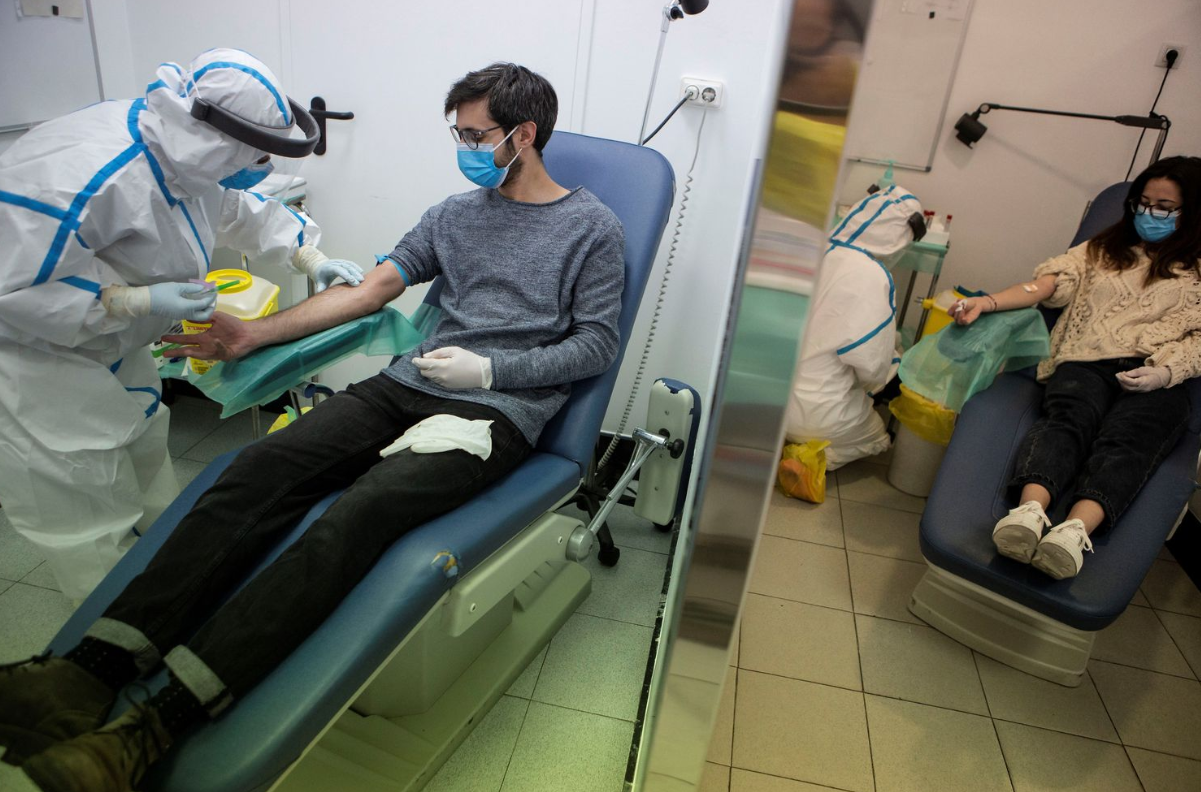
Antibody Study Update - What Conclusions Can We Now Draw From COVID-19
It's been a while since I did an update on antibody studies, and what that might mean for actual infection rates, associated fatality rates and more. In this post, I will focus on recent antibody studies from both Spain and Sweden. First, let's summarize what we know already:
A very important point to note is that antibodies typically take approximately 2 weeks post infection to form and be detectable, meaning a study done today is actually measuring the level of infection about 2 weeks ago, and as we know things can change quite quickly, especially over the span of weeks.
Santa Clara County - 3330 people were tested for antibodies in early April. At that time, about 3% of people were shown to have antibodies - over 60x more than what case numbers suggested at the time.
Chelsea Massachusetts - A small, but random 200 person study was carried out in mid April. At the time, Chelsea was considered the epicentre of COVID-19 infections in Massachusetts. Of the 200 people test, 32% had the antibodies which is about 50x the level of reported cases at the time. It would also mean that the infection fatality rate (IFR) at the time of reporting would have been 0.3%.
Colorado - A study of 986 people from the end of March indicated 23 people likely had been infected already, or 2.3% of the population.
L.A. County - In a study released on April 20, results indicated that around 4% of the adult population had already been infected, or about 40x more than reported cases. This would reduce the IFR to 0.2%.
New York - In a study released on April 23 where 3000 people were tested for antibodies (about half from NYC and half from the rest of the state), results indicated that around 21% of those in NYC and about 4% from the rest of the state had already been infected. At the time of this study, this would mean the IFR would be reduced to 0.5%.
Miami-Dade - In a study released April 25, researchers conclude that around 6% of the county had been infected, which reduced the IFR to under 0.2%.
Heinsberg Germany - In a study announced on April 9, 500 people were tested in one of Germany's hardest hit regions. It was established that 14% of people already had COVID-19, reducing the IFR to under 0.4%


Again, very important to note that the above studies are now 1-2 months old so the infected population will be much higher today, but even at the time it was very interesting to see how things were moving and what the real IFR may look like. Fast forward to present day and we have 2 key studies to look at; Sweden and Spain.
Spain - In the largest study done to date, Spain tested 70K people for antibodies. The results differed widely from place to place, indicating as many as 11.3% were infected in Madrid (Spain's epicentre of their outbreak) whilst nationwide the figure was 5%. This would mean the IFR for Spain as a whole is around 1.1%. That number is higher than we would like to see (obviously we want to see 0, but let's move beyond the obvious), but let's delve deeper. As of April 30, Spain had 25000 deaths, 16000 of those in LTC (64% - more on the importance of this below). On top of this, 20% of the Spanish population is over 65, and Spaniards in general are much closer to their elders than in other parts of the western world (similar to Italy). They often live in multi-generational households and of course Spaniards tend to be a little more touchy feely than us in North America. Whilst a 1.1% IFR worldwide wouldn't be a great result, it's very unlikely it's even close to that. Spain is among the hardest hit places on Earth, with a comparatively older population and a very serious issue in LTC. If you were to separate just LTC out of the picture in Spain, the non LTC IFR would be well under 1% and no doubt in line with the other studies already discussed.
The linked article regarding Spain has a quote as follows: "If the percentage of infected people who eventually die is around 1.1%, as the study suggests, the cost in human lives of herd immunity would be between 200,000 and 300,000, making the method unacceptable. Epidemiologists consulted by this newspaper said that social distancing measures must remain in place until a vaccine becomes available."
Forget the ridiculousness of the last sentence, given there is no guarantee of a vaccine, or the fact it could take years. The real issue, and the reason why it's not always sensible or prudent to put all your faith in so called "experts", is the indication that the Spanish IFR of 1.1% would continue to be applicable to their country as a whole as their infection rate rose from 5% to 60% (herd immunity), and as a result a strategy of herd immunity is not acceptable. It doesn't take an Epidemiologist or any other professional to see the blatant flaw in the entire statement. First, lets be clear on what a herd immunity strategy is. Basically, it's the idea that if you expose people to the virus, once the population infection rate approaches 40-60%, the transmissability of the virus is significantly reduced and will likely fizzle out. The expert assertion above does not account for the fact that 64% of Spain's deaths are in LTC and is something that can surely be mitigated going forward. In fact, it's quite likely their LTC facilities have already largely been affected. What I mean is, it doesn't take an expert Epidemiologist to figure out that as more and more of the Spanish population becomes infected, a smaller and smaller portion of those people will be from LTC facilities because there are only so many people in LTC facilities. As a result, basic math and statistics concludes the IFR will continue to reduce as infection rates become more widespread. The current IFR of 1.1% does not reflect the probability of any random person who contracts the virus dying in Spain, it's 1.1% including the huge portion of people from LTC that have already contracted it and died. If you protect LTC facilities, everything changes. It's in spite of these factors that the IFR is only 1.1%, in a worst case scenario, and most certainly not indicative of what would happen across the world, and this is proven by every single other antibody study that was done. Nuance matters. It's very easy to turn these figures into deadly stories of horror, but it's really not the case. Outside LTC facilities the world over the story is very, very different.
Sweden - In a study completed at the end of April, meaning it is really testing the situation around mid April, results found that 7.4% of the population in Stockholm had already been infected. Sweden’s state epidemiologist, Anders Tegnell, said the antibodies figure was “a bit lower than we’d thought”, but added that it reflected the situation some weeks ago and he believed that by now “a little more than 20%” of the capital’s population had probably contracted the virus.
I find Sweden to be such an interesting case due their no lock down approach. As expected, they have received much criticism for this and are constantly compared across Europe (in brackets I will include each countries current deaths per 1M population), which they are far lower in deaths per capita (Sweden is 384) than France (433), Spain (602), Italy (541), Belgium (797) and the UK (541), but are much higher than their Nordic counterparts in Norway (43), Finland (55) and Denmark (97). Proponents of the Swedish strategy point to the fact Sweden is faring much better than places like Spain and Italy, without crippling their economy and doing so whilst not overwhelming their healthcare system at any point. They also indicate they will likely fare far better in the event of a 2nd wave since they will have had more exposure. Critics of the strategy point to how much worse Sweden is doing compared to their neighbours in Norway, Finland and Denmark. The answer, as usual, is likely somewhere in between. Let's just look at some basic facts and see where the ball lands:
- All above mentioned countries instituted lock downs, from Norway to Italy (except for Sweden). The death tolls for these countries range from among the best in the west to the very worst. That is a wide array of results for countries with similar strategies.
- The study I previously reported on linked HERE concluded that there was no additional benefit to a lock down over basic social distancing guidelines when it came to virus infection and death rates. Looking at Sweden vs other European countries would appear to bare that out, indicating there are far more significant factors than whether total lock downs are implemented or not.
- Sweden has had a significant problem in their LTC facilities. This is surely a failure to protect those most vulnerable, but that is a statement that can be made all over the world and not a reflection of any particular strategy. 75% of Sweden's deaths have been within their LTC system. If those are removed, their death rate falls to under 100/1M, in line with Denmark. That said, if you remove LTC deaths worldwide, the entire pandemic looks a whole lot different.
Perhaps one of the most interesting findings in all this is Stockholm's 7.4% infection rate. This study is about 2-3 weeks newer than the studies quoted above, meaning they are hard to compare but certainly all the previously mentioned studies would have a higher infection rate at the same point the Swedish study was done. This means that it doesn't appear Stockholm has a significantly higher proportion of people infected than other places, and far less than some, such as NYC. Critics have indicated this means that herd immunity is still far off, and therefore the Swedish approach has not worked. If Sweden's relatively high death rate is a direct result of their no lock down approach, then common sense would tell you that their rate of infection would be widespread and significantly higher than all other places, especially given their major outbreaks in LTC. That said, their infection rates aren't much, if any higher than these other places. Miami-Dade, for example, appears to have a 6% infection rate several weeks before Sweden reports a 7.4% infection rate. Heinsberg Germany has an infection rate double that of Stockholm.
No matter what way the data is spun, the data appears to conclude 2 basic things: 1) The lack of lock down likely has not gotten Sweden any closer to herd immunity (though they say officially that was not the inherent intent of their strategy), meaning the spread of the virus is not closely, if at all related to lock down strategies, and 2) The lack of lock down has not caused a measurable increase in cases/infection vs other places that have done antibody testing, thus confirming the US study that concluded instituting lock downs over and above social distancing has no benefit. This also means the Swedish death rate is not a result of their strategy, but due to other factors. The main factor quite obviously being the virus entering LTC.
I think you will find, all over the world, the main factor in how many people die has very little to do with lock down strategies and everything to do with LTC. It's already abundantly clear that the virus overwhelmingly impacts older people, especially over 80 (like just about any other virus or illness, to be fair). In Nova Scotia, outside LTC no one under 80 has died. The NS case fatality rate (CFR) outside LTC is just 0.3% (2 deaths, 661 cases). If a very conservative estimate is that there are twice as many cases as reported (most places have reported a minimum of 10x), that would reduce the outside LTC CFR, or now known as IFR as we are talking about total infections, not just cases, to 0.15%. In Quebec, where about 63% of Canadian deaths have occurred, not a single person under 20 has died and 77% of their 3900 deaths have been in LTC. Overall in QC, 91.4% of deaths have been those aged 70+ and 97.5% aged 60+.
Especially when talking about death rates, I think it's very important to separate LTC data and non LTC data, because the point of death rates in general is to be able to compare data from place to place, but also to get a sense of how fatal the disease is. Issues in LTC, whilst widespread, are not reflective of the danger the virus presents to the average, random person. It's also important to break it out by age, but forget that for now. If you want to know what your chances of dying are if you contract a disease, you refer to the IFR (infection fatality rate). Let's just use NS for a moment, and let's continue to assume that there are 2x the number of infections compared to reported cases. If you do not remove LTC data, you get an IFR in NS of 2.75% (far worse than Spain), meaning that your chances of dying if you get the virus is just under 3%. Not horrific numbers but high enough that you probably don't want to risk getting it (again, ignore the fact there are very clear differences across age groups). Now, the above statements assume the population has been infected roughly at random, meaning any random person who gets the disease has about a 3% chance of dying from it. The issue is, the 2.75% IFR is anything but random. We know that 56/58 deaths in NS are actually confined to LTC facilities (all residents, no staff) where generally sick, elderly people are living; that is the antithesis of random. It's isolated and not at all indicative of society at large. As a result, to truly know what the chances are of dying if you get the virus, you need to remove LTC. Once you do that, the IFR becomes 0.15%, meaning you have a 99.85% chance of survival if you become infected.
This post has turned out to be far longer than I initially intended, but I really wanted to dig in to some key facts that make a huge difference in how we look at this virus, and the reality of how we can react to it, the implications of different strategies, and how even experts often make assertions that are way off base, all the time. Based on the facts and data that are readily available and I have analyzed to death, I don't see how it makes sense to do anything other than protect LTC facilities and get the rest of the world back to normal as quickly as possible. You could protect LTC in a number of ways, but in the short term, testing 100% of staff daily and not allowing visitors would seemingly be a good start. This strategy would seemingly be especially important (and hopefully effective) going forward once what has already been done has run its course. Beyond that, to start allowing visitors at some point would require a visitor to be tested as well. Hopefully quick tests can become more widely available to allow for this. How about putting significant resources into developing cheap, widely available tests where results can be had quickly (thinking a few minutes) so that we can test ourselves before going to see Grandpa at his house or before going to see your severely asthmatic Aunt. The biggest concern I have out of all this is that to date, for all the places that have already re-opened or at least have announced plans, I haven't heard a single plan that included any detail on how they plan to keep the virus out of LTC, nothing at all. In fact, in Canada specifically, it absurdly seems as though the plan is no plan at all. What I mean is, they are waiting until new cases drop sufficiently and then re-opening slowly, and that's it, just hope for the best. No plan for LTC, and statements to the effect "if we see a spike in new cases, I won't hesitate to shut it back down". Why would there not be a spike? Most of us don't have any immunity, the virus started with just 1 case at some point, so of course it's going to spread that's just basic common sense. If the strategy is to just hope for the best, we might as well stay locked down as that seems like what will inevitably happen again. It's as if all the data I have presented doesn't exist or has been disregarded or not looked at in any way as far as formulating policy and a way forward. If cases spike, and they will without question, that's actually OK as long as those spikes don't occur in LTC facilities. People with severe underlying conditions will no doubt take their own precautions when venturing out anyway, at least for awhile. I can't say it enough, you keep it out of LTC and the majority of the rest of the population SHOULD go out and get it. We should WANT to see that spike in cases, as long as it's the right people, which it could be if there was actually a plan. Yet at this point, the only plan appears to be to yell vaccine and stick their heads back in the sand.
I digress.

